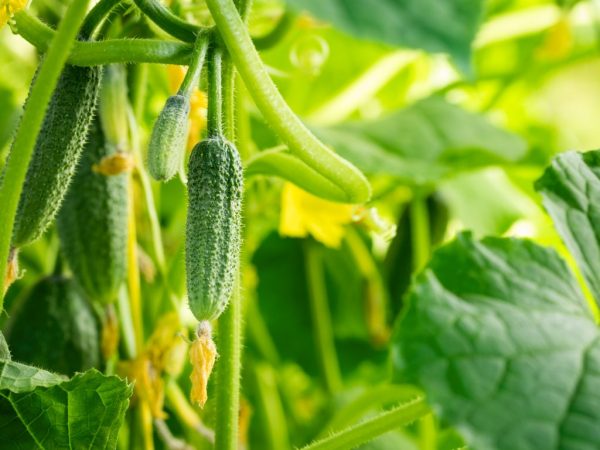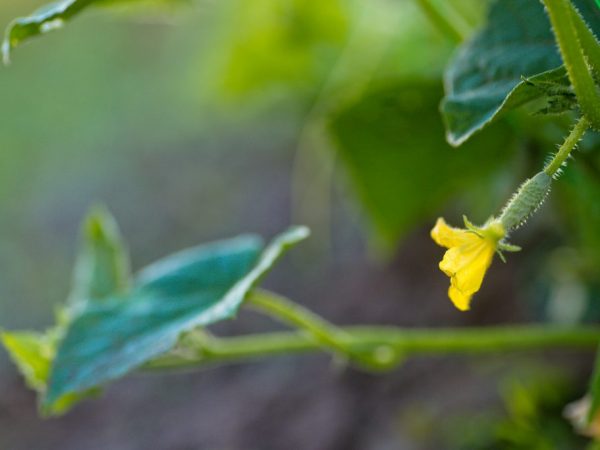Characteristics of Malysh cucumbers
Cucumber variety Kid will appeal to those gardeners who prefer small gherkins. Its characteristic speaks for itself: the bush culture is unpretentious in care and is universal in use.

Characteristics of Malysh cucumbers
The fruits are distinguished by excellent taste and do not taste bitter, they are stored for a long time and do not deteriorate during transportation.
Variety characteristic
Cucumber Malysh is an early bee-pollinated hybrid that yields already 40 days after germination.
Description of cucumber Malyshok:
- the bushes of the culture are small, richly branched, their lateral shoots are poorly developed;
- the length of the main stem does not exceed 40 cm;
- fruits are dark green, covered with large tubercles;
- the shape of the cucumbers is elliptical, size - no more than 10 cm, weight - up to 110 g;
- fruits are tied in knots, in each - up to 6 pieces. For the entire growing season, the bush gives up to 50 fruits.
Cucumbers taste great, they are juicy and tender. They are used both fresh and for pickling and for canning. The description of the variety confirms that it is a favorite variety of housewives.
Advantages and disadvantages
Cucumber variety Malyshok has already become popular among domestic gardeners. It has a lot of advantages:
- differs in early maturity and excellent germination;
- has excellent taste, does not taste bitter;
- used fresh and suitable for conservation;
- has good transportability;
- stored for up to 10 days without losing the presentation;
- is compact;
- resists disease conditions and pests well.
The disadvantages of the bush can be considered intensive fruit formation. Cucumbers need to be harvested every day, otherwise they will overripe. Overripe fruits have a coarse skin and become tasteless. The plant is grown exclusively in open field conditions.
Planting cucumbers
Seeds for seedlings are sown in April-May, plants are planted in open ground in the first decade of June. Sprouts rarely plant, 50 cm x 50 cm, to a depth of 3-4 cm.
You can immediately sow seeds in open ground, to a depth of no more than 2 cm.The soil should warm up enough until that time, up to 15.
Soil preparation
The soil for this class should be light and non-acidic. It is necessary to prepare the site in the fall; it must be well lit. A slight darkening will not interfere with the normal growth of plants, and in hot summers it will even protect from the scorching sun.
Tomatoes, legumes, corn, and early varieties of potatoes are good predecessors of the crop. It is not recommended to sow Krepyshok after plants of the pumpkin family and garlic.
The land is dug up before and fertilized with manure (a bucket for each m2). If there is no organic matter, mineral fertilizers are applied (25 g of potassium salt and about 40 g of superphosphate).
In the spring, the garden bed is dug up again and sprinkled with ammonium nitrate: 20 gr. per 1 m2.
Planting

Plant care consists in watering and loosening the soil.
Seeds from the store do not require processing before sowing.Seeds collected on their own are soaked in a weak solution of nitrophoska, and then placed in a refrigerator for 3-4 hours. This treatment will harden the seeds.
Seeds are sown in seedling boxes or directly into open ground. Disposable cups can be used instead of boxes. For boxes and cups, you can use a ready-made substrate from the store, or take soil from the site and add humus to it.
If the seeds are sown directly into open ground, then this should be done in late May or early June. At night, the garden bed at first needs to be covered with agrofibre or film.
Care
Baby cucumber care is the same as for other varieties. It consists in watering, feeding and loosening the soil.
The soil around the plant is regularly loosened to prevent the growth of weeds. Their roots can damage the root system of cucumbers, as well as provoke its decay. Constantly loose soil provides normal air access to the plant, which increases its immunity.
Sugar syrup is used to attract bees. They are sprayed with crops in dry weather.
Taking care of bush crops is pretty simple. But some nuances are still inherent.
Watering
The F1 toddler needs frequent watering. Watering needs to be done with a weak pressure, a strong pressure washes out the soil and exposes the roots.
The ideal option would be:
- Drip irrigation.
- Sprinkling.
Watering is done once a day. If the weather is dry and there is no rain, the plant is watered twice.
Fertilizer
Variety Malysh F1, like all crops of an early ripening period, grow very intensively, therefore they require not only constant watering, but also top dressing. The first time the culture is fertilized before flowering, the next fertilizing is carried out every decade.
The culture is fed with the following solution:
- 10 liters of water;
- urea, potassium sulfate, superphosphate - 1 tsp;
- 200 g mullein mushy consistency.
Instead of manure, you can use Humanit (1 tablespoon per 10 liters of water). In specialized stores, you can also buy fertilizers "Nursery", "Fertility", "Ideal", etc.
Pest control
The culture can be affected by fungal disease states. Fungal spores are found in the soil, and seeds can also be infected. Therefore, both the seeds and the soil are treated before planting. Seed treatment was mentioned earlier, the soil is treated with Redomin-Gold fungicide or watered with saline solution (200 g of salt per 10 l of water), or potassium permanganate solution.
Diseases of cucumbers, which are the most dangerous:
- gray and white rot;
- root rot of cucumbers;
- olive spot.
The gardener must constantly monitor the state of the F1 Kid. When the first signs of the disease appear, react quickly and carry out timely treatment, and timely feeding is the best prevention of painful conditions. It strengthens the immunity of plants and allows you to fight infections and pests.
Useful Tips
Experienced gardeners who are engaged in growing Baby F1 warn beginners about possible mistakes:
- In bush crops, after the formation of 5-7 leaves, the tip of the new branch is pinched off, but this cannot be done with the Kid, since the bush is compact, and the length of the main branch does not exceed 40 cm.
- It is necessary to adhere to the distance between seedlings or seeds when planting. Too dense plantings are poorly illuminated by the sun, which provokes rotting of stems and fruits.
- Seedlings must be hardened before planting. A week before planting, the sprouts are taken out into fresh air.
- Avoid waterlogging of the soil and stagnant water, otherwise the roots will rot.
- It is not recommended to sow seeds in the same bed.
Compliance with simple rules of care allows you to grow the Malyshok cucumber variety in various regions of the country. His description speaks of many of its advantages over other early-maturing hybrids.

